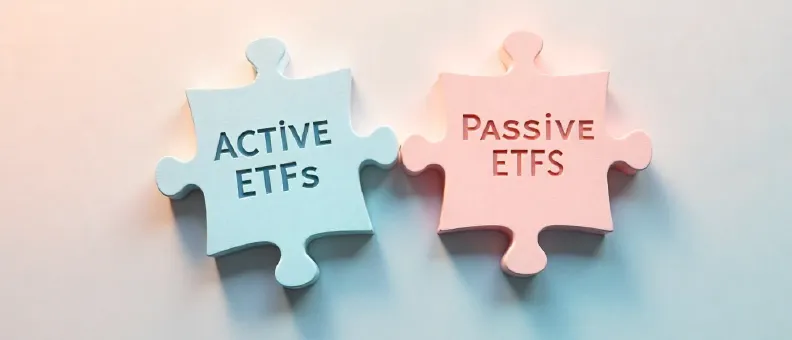Active vs Passive ETF: Understanding the Difference


Exchange-traded funds (ETFs) are gaining popularity, but not all ETFs are built the same. Globally, they fall into two broad categories: index-tracking (passive) and manager-driven (active). While passive ETFs are widely available in India, actively managed ETFs have not yet been introduced. However, understanding the distinction between active vs passive ETFs is still valuable—for context, global exposure, future developments and for investors who have international brokerage accounts.
This article will tell you how each style works, what each costs, and the risks involved.
- Table of contents
- Understanding passive ETFs
- What are active ETFs?
- Key distinctions: Passive vs active ETF investing
- Choosing between active ETFs vs passive ETFs
- Common errors to avoid
Understanding passive ETFs
Passive ETFs—which are like index funds in an ETF wrapper—mirror a benchmark such as the Nifty 50, BSE Sensex, or S&P 500. Portfolio managers buy every stock in the index at the same weights and change holdings only when the index itself rebalances.
Pros of passive ETF investing
- Cost-effective: Lower expense ratios than actively managed funds translate to higher net potential returns over time.
- Transparency: Holdings do not change much and can be easily monitored by looking at the benchmark index.
- Widely diversified: One ETF can provide exposure to numerous securities, depending on the benchmark index.
Cons of passive ETFs
- No potential for outperforming the market: The aim of passive funds, including ETFs, is to match the performance of the benchmark index (subject to tracking error) rather than outperforming it.
- Lesser control: If an index includes an overvalued or poorly managed company, the fund manager still has to hold it until the index is rebalanced.
- Market weighted: Market-cap weighting for broad market indices puts a significant portion of your money into the largest companies, resulting in some concentration risk.
What are active ETFs?
Active ETFs are like actively managed mutual funds. A fund manager designs the portfolio based on regulatory mandates, the scheme’s objective and their investment strategy. They can also rebalance the portfolio as required. The aim is to outperform the benchmark in the long term through strategic stock selection and active management.
Pros of active ETF investing
- Alpha potential: The fund has the potential to deliver higher returns than the market if the stocks in the portfolio outperform the benchmark index.
- Tactical flexibility: Managers may hold cash, use derivatives, or move sector weights—tools not available to passive strategies.
Cons of active ETF investing
- Higher costs: Higher expense ratios can eat into net returns over time.
- Manager risk: Apart from market conditions, the fund manager’s decisions can influence fund performance.
Key distinctions: Passive vs active ETF investing
| Feature | Passive ETFs | Active ETFs |
|---|---|---|
| Goal | Track index | Beat index (alpha) or meet a defined objective |
| Expense ratio | May be comparatively lower because of passive approach | Can be comparatively higher because of aim to generate alpha |
| Portfolio churn | Low, portfolio can only change when the index rebalances | Depends on the fund manager’s approach |
| Return potential | Aligns with benchmark performance (subject to tracking error) | Has the potential to outperform the market over time |
| Suitable for | Investors seeking cost-effective, long-term investments. | Investors with a bigger risk appetite seeking higher return potential. |
Read Also: ETF vs Mutual Fund: Meaning, Types, Key Differences and Investment Tips
Choosing between active ETFs vs passive ETFs
- Active ETFs can be suitable if you prefer:
- Lower costs and minimal portfolio churn
- Broad market exposure without active decision-making
- Simpler access as they are available in India
- High transparency and daily disclosure of holdings
- Fewer regulatory or tax reporting hassles
- Choose active ETFs if you:
- Seek potential outperformance (alpha) through active management
- Are comfortable with higher expense ratios
- Want exposure to thematic or concentrated strategies not available in India
- Are willing to open and maintain an international trading account under LRS
- Can manage forex transfer, tax reporting (Schedule FA), and compliance overhead
To sum up, passive ETFs offer lower cost, ease of investing (for Indian citizens) and lower risk. Active ETFs offer flexibility and the potential for higher returns in the long term, but with added effort and complexity, as they are not available in India.
Common errors to avoid
- Overlooking costs: Paying high fees for active ETFs that closely track an index may undermine returns.
- Chasing performance: Strong historical returns may not persist if the underlying strategy loses effectiveness. (Past performance may or may not be sustained in future)
- Ignoring portfolio overlap: Holding multiple ETFs without reviewing constituents can lead to unintended concentration.
- Disregarding liquidity: Niche or low-volume ETFs may carry wider bid–ask spreads, impacting execution quality.
Conclusion
There is no one-size-fits-all decision in the active vs passive ETF debate. Passive funds offer broad, low-cost exposure, which may be suitable for investors seeking a hands-off and cost-effective approach. Active ETFs have the potential to outperform the market or tap into niche strategies and sectors, but entail higher costs. For Indian investors, an international trading account and compliance with international investing laws can make the investment process more challenging.
Read Also: ETFs vs. Stocks: A Guide to Similarities and Differences
FAQs:
Is it better to invest in active or passive funds?
There is no inherently ‘better’ option. If low costs and market-matching return potential appeal to you, passive funds may be more suitable. If you want outperformance potential or access to a specific investment strategy, you may find active funds more suitable.
Are active ETFs better?
There’s no universally correct answer—it depends on your financial goals, investment style, and comfort with complexity. While Active ETFs have the potential to outperform the market, Indian citizens need an international trading account and compliance with regulatory requirements around international investing. This can entail additional effort in terms of remittance, documentation, and tax reporting. Ultimately, the choice should reflect your preferences around cost, involvement, and access.
What are the disadvantages of passive investing?
Passive strategies need to replicate an index, and the fund manager has no discretion over the portfolio. This means accepting all the index’s constituents, including potentially overvalued stocks or underperforming companies. There is also no opportunity to outperform the benchmark. Moreover, cap-weighted indices can become concentrated in a few large stocks, increasing portfolio bias and resulting in some concentration risk.
How to tell if an ETF is active or passive?
As mentioned, there are no Active ETFs in India at present. If investing in an international ETF, read the prospectus or factsheet for scheme details.
Should I invest in active or passive funds?
It depends on your goals and risk appetite. You can also consider a balanced approach, with some passive funds for low-cost diversification and a few active funds for distinctive exposure or risk-adjusted alpha.
Mutual Fund investments are subject to market risks, read all scheme related documents carefully.
This document should not be treated as endorsement of the views/opinions or as investment advice. This document should not be construed as a research report or a recommendation to buy or sell any security. This document is for information purpose only and should not be construed as a promise on minimum returns or safeguard of capital. This document alone is not sufficient and should not be used for the development or implementation of an investment strategy. The recipient should note and understand that the information provided above may not contain all the material aspects relevant for making an investment decision. Investors are advised to consult their own investment advisor before making any investment decision in light of their risk appetite, investment goals and horizon. This information is subject to change without any prior notice.
The content herein has been prepared on the basis of publicly available information believed to be reliable. However, Bajaj Finserv Asset Management Ltd. does not guarantee the accuracy of such information, assure its completeness or warrant such information will not be changed. The tax information (if any) in this article is based on prevailing laws at the time of publishing the article and is subject to change. Please consult a tax professional or refer to the latest regulations for up-to-date information.